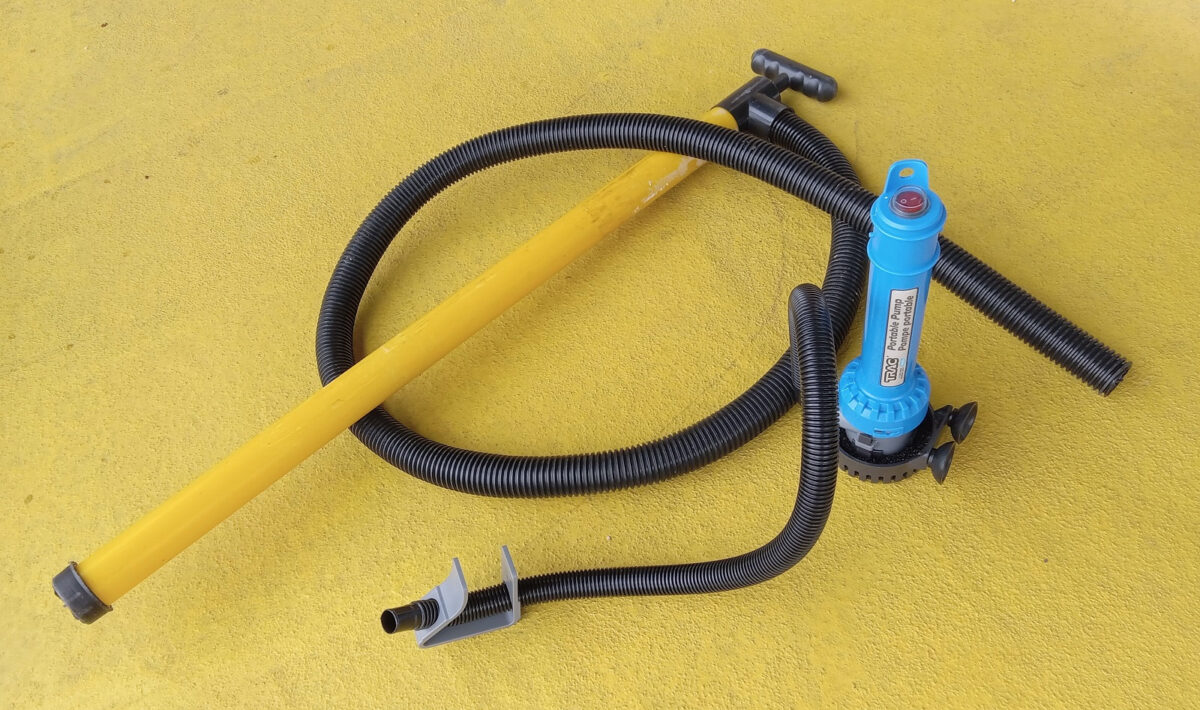To put this problem in proportion, there is very little water that accumulates at the bottom of the S4 Microskiff’s hulls – It’s extremely rare to have more than a gallon in each hull at the end of a trip in very choppy water and 3 ft waves, and this amount of water affects neither comfort nor stability, or anything going on onboard.
It takes a minute or two to remove this amount of water from the hulls using a manual bilge pump or a portable electric pump, and even a large size towel is enough to absorb it effectively.
Absorbing the Water With a Towel
Typically, S4 Microskiff owners do what other owners of small boats, canoes, and kayaks do at the beginning of the trip, which is to lay an old large-size towel on the bottom of each hull, and let it absorb whatever water gets into the cockpit. It’s a perfect solution, and if you notice that a towel absorbed as much water as it can, you can squeeze the water out of it by holding it outside the cockpit and twisting it – It’s both simple and effective.
Hand Bucket
This simple and effective tool is still popular among boaters, and it works well, especially if you need to throw a lot of water out of the boat in a short time. It’s less effective if you want to dry the bottom of the hulls completely, and it’s tricky to use it while you’re seated on the saddle seat of a Wavewalk S4 microskiff or W720 kayak-skiff, because of the seat’s height.
Bilge Pump
Some people carry onboard a manual bilge pump. This works too, except that in most cases, there isn’t enough water at the bottom of the S4 hulls to prime the bilge pump, and this is where the towel works better, and it can leave the bottom completely dry.
Others use an electric portable pump that works similarly to a manual pump. No problem here too, except that it’s likely that the water on the bottom of the hulls of your S4 isn’t deep enough to prime such pumps, since typically, you need at least 1/8″ of water for this.
Tip: Manual bilge pumps are simpler, and therefore more reliable.
Testing a Portable Electric Bilge Pump
We tested the Trac Portable Pump from Camco, and we liked it at first. The reason we chose it in the first place was that the three D size batteries go inside the pump’s housing, and this avoids possible complications from using an external battery.
We also liked the fact that this pump is taller than some other models, which makes it more comfortable to use when you’re onboard, and it’s fully submersible, so no problem if if falls in the water.
The pump comes with a hose and a clip for it, which is another advantage.
This electric bilge pump’s throughput isn’t impressive, but it’s enough to deal swiftly and effectively with the little water that we’re talking about.
Tip 1: We removed the suction cups from the bottom of this pump, in order to enable priming it in even skinnier water.
Manual vs Electric Bilge Pump
Both cost about the same (about $30) and both work well.
The advantage of the electric pump is that it does the work that your muscles do with the manual pump. It’s not a big thing, but it’s a nicer feeling not to have to work when you’re tired at the end of a long trip, even if it’s just little work.
The advantage of the manual pump is that it’s foolproof, in the sense that you’re not required to remember to replace the batteries, and it’s more likely to be in working order when you’d need it.
Bottom line – Manual is simpler and more reliable, and therefore better.
Should You Take a Bilge Pump or a Hand Bucket Onboard?
The answer is Yes, absolutely and unequivocally, especially if you go in the ocean, or on a swift river. Why? Because stuff happens, and even if you’ve had a hundred totally dry trips before, it doesn’t guarantee that in your next trip you won’t be required to pump out more water than you’re used to, and using an old towel can be too slow and too hard for large amounts of water.
Tip: In boating, ‘Stuff Happens’ is the rule.
Drain Plugs
This discussion would not be complete without mentioning drain plugs, such most medium and large boats feature. These plugs start working only when the boat is moving above a certain speed.
Again, in this case, the small quantities of water that we’re talking about are not worth taking the risk of drilling under the waterline. This is especially true in view of the fact that the S4 and W720 are made from Polyethylene, a polymer resin to which practically nothing sticks well, so that in the long run, drain plugs could develop leaks if not reinstalled or at least re-waterproofed every now and then,.
In sum, in our opinion, installing drain plugs is a solution that’s disproportionate for the purpose of draining the hulls of the S4 microskiff and the W720 kayak-skiff, and it doesn’t fit in the context of maintenance free boat such as these boats are. Therefore, it may be worth consideration only in very special cases where the boat is expected to get filled with water continuously, such as when you drive your S4 in a storm, but we recommend not to try taking yur S4 or W720 in such circumstances, and stay home whenever the authorities issue a Small Craft Advisory for your area, because Stuff Happens…
Do you have any questions about this article?


